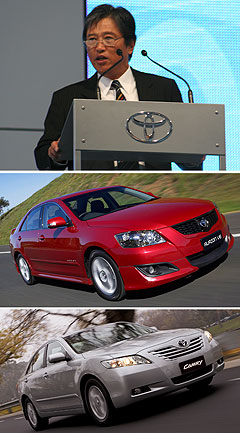Toyota Australia looks to build third model line
BY TERRY MARTIN | 3rd Mar 2009

Domestic sales of Camry and Aurion fell 12.4 per cent and 11.2 per cent respectively in 2008, and although this was offset by record exports of more than 101,000 units for the calendar year, Toyota Australia suffered a 10 per cent fall in demand from its all-important Middle East market.
Accordingly, Altona production is being reduced from 480 units a day to around 420.
Speaking to GoAuto at the Melbourne International Motor Show, Mr Yasuda said a third model was still considered integral to sustaining its Australian manufacturing operations.
“To sustain the volume, I think we definitely need some third model,” he said. “It will happen not next year, or in two years, but it will come.
“It is probably more feasible to have this (based on) on the current platform, but of course we have other options. I don’t want to talk about it in detail, but my personal opinion is that we should use the set platform – it’s easier for everyone.”This is expected to be the Kluger SUV, which shares its platform with the Camry and enters a new generation around 2012. Mr Yasuda acknowledged that the new-generation Kluger – which GoAuto understands will not be built in Japan, as is the case now – was a contender.
“If we build (Kluger) here, obviously there is no need to produce (from Japan) for the Australian market, because we are the only right-hand (drive) market for this Kluger,” he said. “It has nothing to do with the US market. We are an independent market. And we do have our own product planning for the future.”

However, Mr Yasuda insisted that vehicles other than Kluger were on the agenda. “There are other possibilities,” he said.
“We are here, for production, for a long time. We are having a very difficult time, especially our suppliers due to a lower production volume, but we will survive. We will do everything we can to support those suppliers and also ourselves – and our parent company is backing us up very strongly.”Toyota Australia senior executive director of sales and marketing David Buttner told GoAuto that the fall in Middle Eastern demand did not threaten the company’s Australian production operations.
“There has been some decline in demand in the Middle East, but it’s still relatively strong compared to the rest of the regions,” he said. “It’s only contracted around 10 per cent at this juncture, and of course we’re talking to those customers all the time to make sure those markets are still stimulated.
“Naturally, we want to try and maintain those volumes there – that gives us good efficiency levels at the plant, it maintains our levels of employment.” Asked at what point its production operations became unsustainable, Mr Buttner told GoAuto: “That’s the crystal ball question. We’re still remaining very positive about the market, we’re still remaining very positive about our local manufacturing product, both the domestic and export market, and we’ll do everything we can to sustain our volume at the best of our ability at the plant.”While not divulging whether jobs would be cut at Toyota Australia, Mr Buttner said the company had a “very strong desire” to ensure that it would maintain its current staffing levels and that redundancies were not being called for.
“Our people are our greatest asset, and we do everything we can to ensure they have the appropriate skill and knowledge to perform the functions they perform on a daily basis,” he said. “We’ll be doing all we can to support them in the ongoing future.”Mr Buttner also said he was “quite excited” by the prospects for the local industry, despite no signs of recovery in new-vehicle sales at this stage.
“What happens is, we got used to two years of a million vehicles (sales), and when we start thinking it’s not a million vehicles, ‘ooh, the market’s gone to hell in a handbag’. I don’t think it has. I think the market’s still very, very strong, and for those that want to avail themselves of the opportunities in the market – whether it be sub-900,000 or around about 850,000, who knows at this juncture – I feel there’re great opportunities there.
“All we’re focused on as a company is making sure that we continue to innovate, bring good product to the marketplace, to meet what our customers need, and to continue to support our customers and our dealer network.”Mr Buttner said he thought the Australian economy was strong enough to withstand the substantial automotive sales decline seen in Europe and elsewhere.
“When you think that we really felt the global financial crisis about six months later than most other countries – we didn’t see anything until about July last year – and I think that was fundamentally on the back of the fact that we had a very, very strong financial sector and we also had good levels of employment.
“We’re seeing some diminution in employment at the moment but our banking sector is still strong, we’ve seen two very big stimulus packages from the (federal) government … and we still believe there’s great opportunities in this marketplace.”